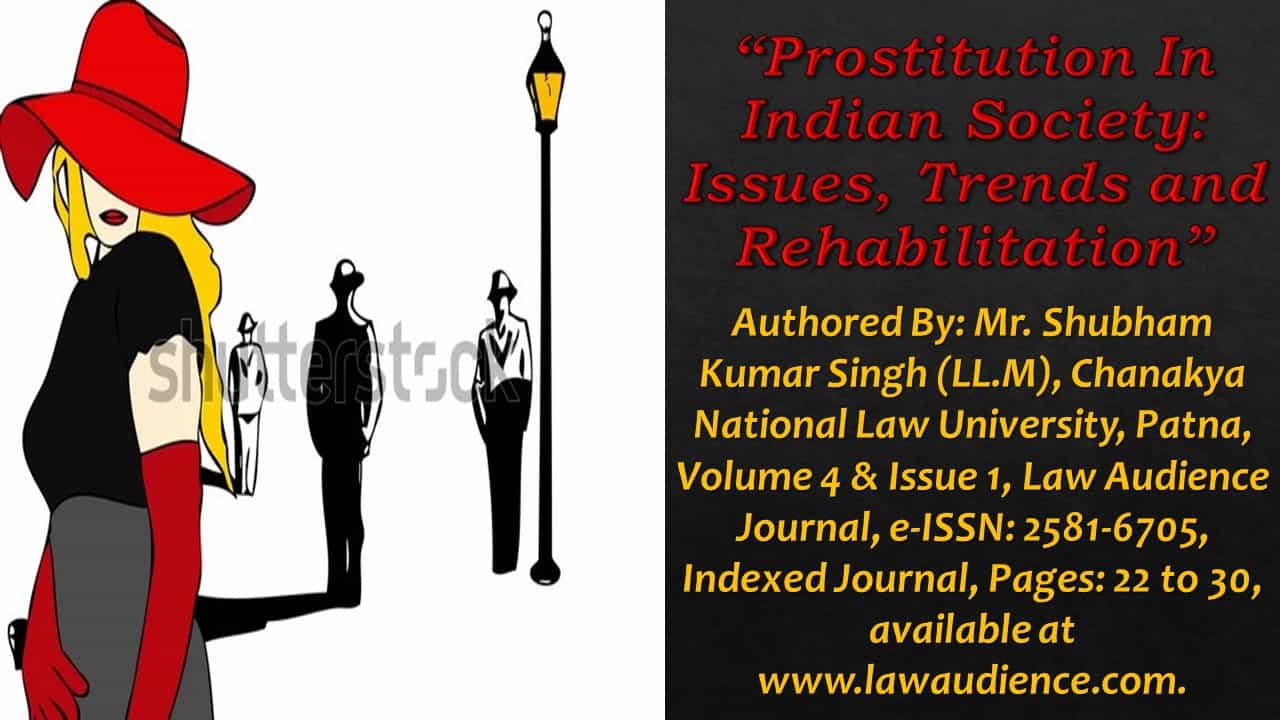Click here to download the full paper (PDF)
Authored By: Mr. Shubham Kumar Singh (LL.M), Chanakya National Law University, Patna,
Click here for Copyright Policy.
I. INTRODUCTION:
“Prostitution has been defined in several ways by sociologists depending on the level of its practice. The most frequently accepted definition, however, is that given in the social science encyclopedia, which defines prostitution as “the practice in which a girl provides her body for promiscuous sexual intercourse for hire, etc.” However, in the Government of India’s “Prevention of Immoral Traffic Act-1987,” a new definition for the term “prostitution” has been coined, which now implies “sexual exploitation or abuse of humans for economic objectives.” Female prostitution is maybe the world’s oldest profession. Unfortunately, it is possibly the most despised occupation”.
II. HISTORY:
Prostitution has a long history in both ancient and modern societies. According to mythology “‘ZOHAR’ and the ‘alphabet of Ben Sira,’ four angles of holy prostitution mated with archangel “Samael,” they were the queen’s demons “Lilith Naamah, Agrat Bat Mahlat, and Eisheth Zenunim. Prostitution was quite common in ancient Greece, and both men and women participated in it. In ancient Rome, it was legal. It is regarded as the world’s obsolete profession. Prostitution is defined as the trade of sexual services for monetary compensation. Prostitution is one of the world’s oldest professions, having been performed since the dawn of organised society. Prostitution is legal in practically every country and in every sort of culture. The Vedas, the earliest known Indian literature, are replete with references to prostitution as an organised and established institution. There are several references in Indian mythology to high-class prostitution in the form of celestial demigods functioning as prostitutes. Menaka, Rambha, Urvashi, and Thilothamma are their names.
An apsara named Menaka caused the downfall of the great sage Vishwamithra, and became the mother of Shakuntala, the immortal heroine of the greatest drama of the world, Abhiguan Shakuntalam written by the great poet Kalidas of India.[1] Prostitution has been practiced in India since ancient times, with the rich hiring ‘Nagarvadhu’ to sing and dance, a practice known in history as “brides of town.” Devadasi was another type of system that was common in mediaeval India. With the arrival of Portuguese and Britishers in India during the Middle Ages, prostitution in India increased. During the British East India Company’s control, the British established comfort zones for British troops, pushing women and children into the sex trade. The first law in this regard was introduced by British India in the form of the “Cantonment Act 1864.” According to this, each regiment was given 12-15 women. These ladies were housed in brothels known as ‘Chakals.’[2]
III. PROSTITUTION IN THE CONTEMPORARY ERA:
Today, India is home to some of the major red-light districts, including Sonagachi in Kolkata, G. B. Road in New Delhi, and Kamathipura in Mumbai. Sonagachi in Kolkata is Asia’s second largest red-light district. Prostitution (the exchange of money for sexual services) is lawful in India, but a number of other behaviours, such as public solicitation, kerb crawling, owning or managing a brothel, pimping, and pandering, are considered crimes. The first prostitution law in independent India was “The Immoral Traffic Suppression Act 1956 (SITA),” which stated that prostitutes might trade privately but could not lawfully recruit or lure customers in public and could not operate any sex trade within 200 yards of a public location. Operating brothel or pimping was also regarded as a crime. This law was later replaced by the “The Immoral Traffic Prevention Act 1986 (PITA),” which was meant to restrict and eventually eliminate prostitution in India by gradually criminalising various types of sex work.
IV. VARIOUS KINDS OF PROSTITUTES:
Prostitutes are generally categorized based on their ‘modus operandi,’ which is as follows:
- Brothel Prostitutes: Their activities take place at a brothel owned by an ex-prostitute. The prostitutes are paid a commission for their sexual services.
- Call Girl Prostitutes: They usually work independently from her location. She may be available directly or through intermediaries.
- Street Prostitutes: This category solicits customers on the streets and takes them to a location of appointment.
- Other Forms: Other types of prostitution can be found in nightclubs, massage parlours, entertainment centres, dance clubs, and so on.
V. REASONS FOR PROSTITUTION:
- Neglectful parenting.
- Bad company.
- Family prostitutes
- Social norms.
- Impossibility of arranging a marriage
- Inadequate sex education and media.
- Prior incest and rape.
- Early marriage and desertion.
- A scarcity of recreational facilities, as well as ignorance and acceptance of prostitution
- Poverty and economic suffering are examples of economic causes.
- Psychological factors include a desire for physical pleasure, avarice, and depression.[3]
VI. LITERATURE REVIEW:
Prostitution: A Medical and Social Science Critical Review:
Prostitution has been practised in our country for centuries. Even in early Indian literature, the words ‘prostitute’ and ‘prostitution’ are referenced; they have been addressed by several names in Sanskrit literature. They are mentioned in the Vedas, Puranas, Mahabharata, and Ramayana. According to the Puranas, the mere sight of prostitutes brings good luck. Women prostitutes were divided into three groups at the time: Kumbhadasis, Rupajivas, and Ganikas. In India, prostitution as a vocation has a long history. There are reasonably good records of prostitution in large Indian towns during the 18th and first half of the 19th centuries of British rule; prostitution was not considered a degrading vocation in that period, as it became in the second half of the 19thcentury. The British and other outsiders had no influence on Indian prostitution. In every region of the Indian subcontinent, temple dancers, noble courtesans, autonomous country girls, and large brothels could be found. Thus, prostitution has existed in civilization for centuries and continues to be prevalent in modern culture.[4]
VII. CONSEQUENCES:
- No doubt, prostitution causes personal, family, and society disorder. The prostitutes’ condition is deteriorating. Both the prostitute and the person who approaches her have a ‘double. Both the prostitute and the person who approaches her have a ‘double
- They suffer from moral collapse and lose the status and position in society those other respectable men and women have. Respectable people despise them, avoid their company, and desire to keep them out of society.
- As a result, the pimp and the prostitute are labelled as “hated and isolated islands.”
- A guy who approaches a prostitute may be infected with venereal diseases,
- and if married, he may communicate the disease to his wife and children. Children born to parents with venereal illnesses are more likely to be maintained for life and are frequently born blind.
- If the wives are aware of the illegitimate and adulterous sexual connection, it causes strain in the family and eventually leads to desertion and divorce.
- There is clinical and psychological evidence that many young males have.
The majority of these workers are treated inhumanely in the beginning of their stay at the brothel (a unit of prostitution). They are routinely beaten in order to instil dread in their minds. They are forcefully forced to entertain customers once they reach the age of 18. Referral to a specialist “It’s most likely unthinkable for them.” Males identified as clients or consumers are exploited. The most obvious outcome for these girls and women is to become pimps. These people are always used by the police and other law enforcement authorities. They not only take their money but also physically attack them. After accomplishing what the brothel owner desires, these workers are effectively placed under house arrest to prevent their probable escape. They can do whatever they want, but just a small portion of their earnings are provided to them. According to the authorities, there are three million sex workers in India. The majority of them are not only HIV-positive, but also suffer from a variety of other ailments. They do not have enough access to medical care.
Prostitution was defined in People v. Rice as “the act or practise of a female prostituting or offering her body to an indiscriminate intercourse with men for money or its equivalent.” Carpenter v. People ruled that the term “prostitute” in its broadest sense encompasses the act of putting oneself up for sale or devoting oneself to heinous goals; it also means what is within one’s control, that is, the prostitution of talents or abilities; and the prostitution of the press. Prostitution is defined as the act of a female providing her body for promiscuous sexual intercourse for hire, whether in money or in kind, under Section 2 (f) of the Immoral Traffic (Prevention) Act (104 of 1956) read with Section 372 of the Indian Penal Code (45 of 1860). In the case of In re: Deva Kumar, it was determined that prostitution entails the indiscriminate use of a woman’s body for hire.
The common law defines a “brothel” as a place where persons of different sexes are permitted to engage in illegal intercourse, regardless of whether the women are common prostitutes or not; running a bawdy house is a nuisance under common law. It is worth noting that, in the case of Sushila vs. State of Tamil Nadu[5], it was held that a single instance of prostitution in a place does not make the place a “brothel”; a similar view was reiterated in the case of, In re: John[6], where it was held that, for the premises to be called a “brothel,” prostitution of a woman must be for the gain of another person. Later, in the case of Krishnamurthy vs. Public Prosecutor[7], the Supreme Court ruled that a place that was earlier used for prostitution could not be considered a “brothel.” In the case of State of Rajasthan vs. Mst. Wahida[8], it was determined that any individual who keeps or maintains a brothel in India, or acts or assists in the maintaining and administration of a brothel, is punishable under the terms of the Immoral Traffic (Prevention) Act, 1956.
VIII. SHALL INDIA LEGALIZE PROSTITUTION?
Some argue that prostitution should be legalised in India and accepted as a part of society because the problem is unavoidable. The advantage of legalizing prostitution in India is that we will have a track record of Sexworkers, since when the dance bars in Bombay were closed, most of the bar dancers went to Gujarat, Karnataka, and other neighbouring states and started their business secretly. Legalizing prostitution will provide these women, who live on the periphery of society, with access to medical services that can help curb the spread of AIDS. There is an urgent need to recognise the sex industry as any other industry and provide it with legal protections. The criminals understand that such persons are unlikely to report the crimes to police since the victims would have to say they were engaged in the unlawful activity of prostitution at the time of the attacks; nevertheless, if it is legal, they will readily go and report this to police.
IX. THE FOLLOWING ARE THE ADVANTAGES OF LEGALISING PROSTITUTION:
- Legalization of prostitution and the sex business will put an end to sex trafficking.
- The sex industry will be controlled if prostitution is legalised.
- Prostitution legalisation will reduce clandestine, covert, illegal, and street prostitution.
- Women in prostitution will be protected if prostitution is legalised because they will have rights.
- Women in prostitution networks want the sex business to be legalised since they are the ones who suffer the most because they have no rights.
- Legalizing prostitution will improve women’s health because they will have easier access to medical services, which they do not have when prostitution is outlawed.
- Recognizing prostitution as an economic activity, allowing Indian women to get work permits as “sex workers.”
X. POSSIBLE SOLUTIONS INCLUDE:
Because prostitution is so firmly ingrained in society, it is an extremely complex issue. As a result, it must be approached from two perspectives.
1) Preventing new players from entering the prostitution business.
2) Rehabilitating women who are already in the prostitute business.
Preventive Measures: Counseling and mentoring programmes aimed at educating the public about the origins and issues of prostitutes, as well as sex education, are urgently needed. More and more economic opportunities should be made available to those who are at risk of becoming prostitutes. Police should be directed to prioritise the registration of cases involving abduction or mistreatment of a female.
XI. TO ENSURE EFFECTIVE PREVENTION, THE FOLLOWING PROCEDURES MUST ALSO BE TAKEN:
- Community Policing: The concept of community policing should be popularized so that civilians and non-governmental organisations (NGOs) can be involved in policing in order to prevent and combat prostitution. Community policing is a philosophy based on the paradigm of problem solving in collaboration, in which the police function as a facilitator and the community is made to share responsibility.
- Second Generation Prevention: The problem of prostitution can be reduced if the children of prostitutes are given a good future. Prajwala, an anti-trafficking organisation in Andhra Pradesh, has made a start. The organisation is making efforts to explore education and self-employment options for the survivors.
- Synergy: The UNODC (United Nations Office on Drugs and Crime), New Delhi, in collaboration with the Government of India, state government agencies, and civil society partners, has established Anti-Human Trafficking Units (AHTU) in Andhra Pradesh, Goa, and West Bengal. These units, with the assistance of trained personnel, are having a significant impact on India’s law enforcement landscape.
In a six-month period, AHTUs in Andhra Pradesh rescued over 700 victims, including over 100 children under the age of 18. They have also detained over 1000 people, including 300 customers. Such units should be established in all Indian states and union territories. (Bedi. Kiran, P.M. Nair; 08) Programmes of Rehabilitation and Follow-up: Because of the tireless efforts of NGO social workers and other social development organisations, it has been recognised that prostitution is one of the biggest social evils and must be eradicated as soon as possible. This can be accomplished by the implementation of a concrete strategy and action plan, of which rehabilitation is an essential component. Physical and psychological rehabilitation are both required. It is important that the government, in collaboration with non-governmental organisations, raise awareness among sex workers about their legal position and rights. All rescued victims should be given gender-sensitive market-driven vocational training. It has been found that the urgent need of sex workers is financial security, as they are unable to earn a living after leaving their previous employment. As a result, a co-operative credit society led by NGOs on their own or with government support is urgently needed. This effort will protect them against the exploitation of money lenders and humiliation at the hands of banks.
XII. CONCLUSION:
Thus, either India should Legalise prostitution, which is the most appropriate approach, or it should enact deterrent measures to minimize the problem of prostitution. Laws should not only be designed to remove prostitutes, but also to change the mindset of those engaged in paid sex by penalising them in such a way that others with the same mentality will dare to engage in similar actions.
Cite this article as:
Mr. Shubham Kumar Singh, “Prostitution In Indian Society: Issues, Trends and Rehabilitation”, Vol.4 & Issue 1, Law Audience Journal (e-ISSN: 2581-6705), Pages 22 to 30 (5th May 2022), available at https://www.lawaudience.com/prostitution-in-indian-society-issues-trends-and-rehabilitation/.
Bibliography:
- The Constitution of India, 1950.
- The Suppression of Immoral Traffic in Women and Girls Act, 1956.
- The Immoral Traffic (Prevention) Act, 1956.
- The Indian Penal Code, 1860.
- Sithanan, Immoral Traffic: Prostitution in India, 9-14.
- Immoral traffic of women and children with special reference to west Bengal by D.K Basu.
- Law relating to crimes against women.
- https://www.ugc.ac.in/mrp/paper/MRP-MAJOR-SOCI-2013-25158-PAPER.pdf.
Footnotes & References:
[1] Law relating to crimes against women.
[2] https://www.ugc.ac.in/mrp/paper/MRP-MAJOR-SOCI-2013-25158-PAPER.pdf.
[3] Immoral traffic of women and children with special reference to west Bengal by D.K Basu.
[4] V. Sithanan, Immoral Traffic: Prostitution in India, 9-14.
[5] 1982 Cr LJ 702 (Mad).
[6] AIR 1966 Mad 167.
[7] 1967 Cri LJ 544 (SC).
[8] 1981 RCC 42.




